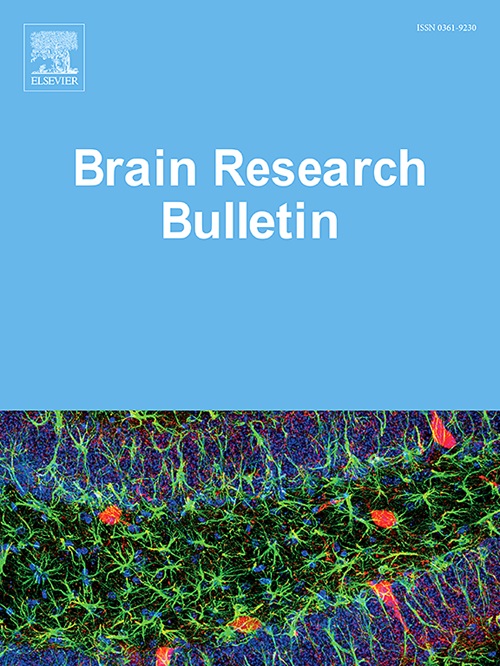Growth of the prefrontal cortical glioblastoma altered cognitive and emotional behaviors via mediating miRNAs and GABA-A receptor signaling pathways in rats
IF 3.5
3区 医学
Q2 NEUROSCIENCES
引用次数: 0
Abstract
The present study investigated the impact of GABAergic signaling and miRNA expression on glioblastoma multiforme (GBM) growth within the medial prefrontal cortex (mPFC) and its associated cognitive and emotional impairments. The implantation of C6 cells into the mPFC induced GBM in this brain region (referred to as the mPFC-GBM) in male Wistar rats via stereotaxic surgery, as confirmed by Magnetic Resonance Imaging (MRI), and Hematoxylin and Eosin (H&E) staining. Repeated microinjections of muscimol, a potent GABAA receptor agonist, directly into the mPFC-GBM (1 µg/rat/2.5 μl) following tumor induction decreased tumor volume and weight, resulting in an increased survival rate. Conversely, a higher dose of muscimol (6 µg/rat/2.5 μl) increased tumor size and reduced survival. Behavioral alterations induced by GBM, including anxiety-like responses, exploratory behaviors, locomotor activity, and memory formation, were assessed using anxiety-like behavior task, the hole-board test, and the novel object recognition test. Muscimol treatment dose-dependently affected these behaviors in the animals with the mPFC-GBM, bringing their performance with that of the sham group at the dose of 1 µg/rat/2.5 μl. Changes in specific miRNAs expressions, including miR-208, −290–295, −345, −743 and −802 were associated with the growth of the mPFC-GBM under muscimol treatment. These findings suggest that GBM growth into the mPFC profoundly impacts cognitive and emotional behaviors which can be improved by muscimol treatment. Considering that the expression levels of targeted miRNAs could be influenced by the growth of the mPFC-GBM, both with or without muscimol treatment, these non-coding RNAs might serve as potential biomarkers for GBM.
求助全文
约1分钟内获得全文
求助全文
来源期刊

Brain Research Bulletin
医学-神经科学
CiteScore
6.90
自引率
2.60%
发文量
253
审稿时长
67 days
期刊介绍:
The Brain Research Bulletin (BRB) aims to publish novel work that advances our knowledge of molecular and cellular mechanisms that underlie neural network properties associated with behavior, cognition and other brain functions during neurodevelopment and in the adult. Although clinical research is out of the Journal''s scope, the BRB also aims to publish translation research that provides insight into biological mechanisms and processes associated with neurodegeneration mechanisms, neurological diseases and neuropsychiatric disorders. The Journal is especially interested in research using novel methodologies, such as optogenetics, multielectrode array recordings and life imaging in wild-type and genetically-modified animal models, with the goal to advance our understanding of how neurons, glia and networks function in vivo.
 求助内容:
求助内容: 应助结果提醒方式:
应助结果提醒方式:


